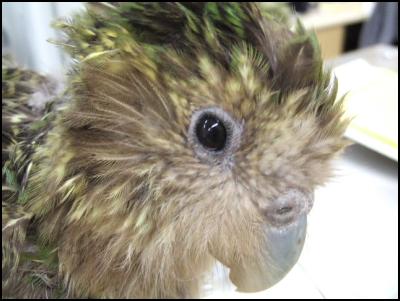Injured Kakapo Returns Home

Click for big version
12 December 2005
Injured Kakapo Returns Home
The injured kakapo chick that has been convalescing at Massey University since being attacked by another kakapo earlier this year has been given the all-clear to return home.
A young female kakapo, named Pounamu, is one of four kakapo chicks that hatched earlier this year. She was attacked in her pen on Whenua Hou by an older male, just days before she was due for release in September. She sustained serious injuries to her neck and beak, and had to be flown to Massey University’s wildlife ward to be treated for her injuries. According to avian biologist Jenny Youl, Pounamu has made an excellent recovery.
“Considering her injuries, and having to undergo two surgeries as a result of her wounds, Pounamu is now in great health,” she said.
“Because her beak was too sore for her to eat, initially we had to feed her using a feeding tube. However, now she is eating really well, and most of her feathers have grown back..”
The growth of feathers is one of the most important parts of her recovery, since they provide protection against the cooler climate at Whenua Hou.
“The kakapo’s feathers act as a warm jacket, to help protect against the cold southern weather,” said national kakapo recovery manager, Paul Jansen.
The Department of Conservation is thrilled about the recovery and return of Pounamu to the population of one of New Zealand’s most endangered birds, with a total of 86 birds remaining in the wild.
“It’s been a very long and tedious process getting Pounamu back to full health, and we are overjoyed to be able to return this valuable female back to the wild,” said Mr Jansen.
Pounamu has spent the last three months at Massey, where she has been benefiting from excellent care, and has enjoyed a varied diet of which kumara chunks and green grapes seem to have been a favourite. She will be returned home to Whenua Hou today to join the other kakapo, including the other three chicks hatched this year.
ENDS
Kakapo facts:
- Kakapo are ground-dwelling parrots. They are excellent climbers, using their beak and claws to climb high into trees.
- Kakapo are essentially flightless, capable of no more than short, wing-assisted jumps.
- They are the world’s biggest parrots, weighing up to 4 kg.
- In the breeding season, male kakapo swell up like a porcupine fish and emit a low booming sound that can travel up to 5km.
- Kakapo look like green owls and move on the ground with a rolling gait.
- They emit a strong fruity smell.
- Kakapo are nocturnal and solitary, gathering only to breed.
- The birds feed on seeds and fruits. It is believed that breeding is triggered by eating green rimu fruit.
- They are very long lived. Richard Henry, the last surviving Fiordland bird, is believed to be at least 50 years old.
- A female kakapo may lay a clutch of between one and three eggs. In exceptional years, for example in 2002, kakapo may lay two clutches in one breeding season.
- Kakapo take many years to reach breeding maturity. Males will take five years, and females, nine to 11 years.
For more information about kakapo, please
visit www.kakaporecovery.org.nz


 Gordon Campbell: On bird flu, AUKUS entry fees and Cindy Lee
Gordon Campbell: On bird flu, AUKUS entry fees and Cindy Lee Susan Botting - Local Democracy Reporter: Ruawai Leader Slams Kaipara Council In Battle Over $400k Property
Susan Botting - Local Democracy Reporter: Ruawai Leader Slams Kaipara Council In Battle Over $400k Property Te Pati Maori: Another ‘Stolen Generation’ Enabled By Court Ruling On Waitangi Tribunal Summons
Te Pati Maori: Another ‘Stolen Generation’ Enabled By Court Ruling On Waitangi Tribunal Summons Peace Action Wellington: Die In for Palestine Marks ANZAC day
Peace Action Wellington: Die In for Palestine Marks ANZAC day Labour Party: Penny Drops – But What About Seymour And Peters?
Labour Party: Penny Drops – But What About Seymour And Peters? Government: PM Announces Changes To Portfolios
Government: PM Announces Changes To Portfolios Family First: Just 1 In 6 Oppose ‘Three Strikes’ - Poll
Family First: Just 1 In 6 Oppose ‘Three Strikes’ - Poll


